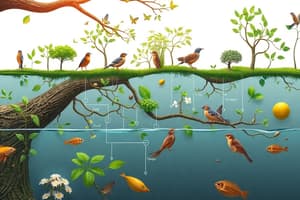Podcast
Questions and Answers
What percentage of languages belong to the Indo-European family?
What percentage of languages belong to the Indo-European family?
- The exact percentage is unknown (correct)
- 70%
- 50%
- 90%
What is the term for switching back and forth between two languages?
What is the term for switching back and forth between two languages?
- Dialect switching
- Language switching
- Language diffusion
- Code switching (correct)
How many languages are estimated to be spoken across the world today?
How many languages are estimated to be spoken across the world today?
- Between 1,000 and 2,000
- Over 20,000
- Between 5,000 and 10,000
- Between 3,000 and 6,500 (correct)
What is the language spoken by the largest number of native speakers?
What is the language spoken by the largest number of native speakers?
What is the term for versions of a language that reflect changes in speech patterns?
What is the term for versions of a language that reflect changes in speech patterns?
What is the name of the earlier language that is believed to be the basis of the Indo-European languages?
What is the name of the earlier language that is believed to be the basis of the Indo-European languages?
Where did the Nostratic language develop?
Where did the Nostratic language develop?
How can language be diffused?
How can language be diffused?
What was the landscape of prairie land in Tazewell County, Illinois, described as in the 1870s?
What was the landscape of prairie land in Tazewell County, Illinois, described as in the 1870s?
What is the primary factor that determines the type of vegetation in a region?
What is the primary factor that determines the type of vegetation in a region?
What is the significance of the top six inches of soil, also known as topsoil?
What is the significance of the top six inches of soil, also known as topsoil?
How does soil influence human activities in a region?
How does soil influence human activities in a region?
What is the relationship between climate and soil characteristics?
What is the relationship between climate and soil characteristics?
What is a key factor in determining the carrying capacity of a region?
What is a key factor in determining the carrying capacity of a region?
What is the primary reason why people have settled in certain regions throughout history?
What is the primary reason why people have settled in certain regions throughout history?
What can be inferred about the relationship between vegetation and human activities in a region?
What can be inferred about the relationship between vegetation and human activities in a region?
What is the primary factor that influences the type of vegetation that grows in a region?
What is the primary factor that influences the type of vegetation that grows in a region?
What is the term used to describe an interdependent community of plants and animals?
What is the term used to describe an interdependent community of plants and animals?
What is the characteristic of soil in a cold, dry climate?
What is the characteristic of soil in a cold, dry climate?
How does the soil in warm and wet climates differ from the soil in cold and dry climates in terms of depth and texture?
How does the soil in warm and wet climates differ from the soil in cold and dry climates in terms of depth and texture?
What is the term used to describe a natural environment that provides the stage for human activities such as farming and raising livestock?
What is the term used to describe a natural environment that provides the stage for human activities such as farming and raising livestock?
What is the process that influences the characteristic of soil in a warm and wet climate?
What is the process that influences the characteristic of soil in a warm and wet climate?
How many types of biomes are mentioned in the text?
How many types of biomes are mentioned in the text?
What is the characteristic of humus content in a cold climate?
What is the characteristic of humus content in a cold climate?
Flashcards are hidden until you start studying
Study Notes
Vegetation Regions
- Vegetation regions are natural environments that provide a stage for human activities like farming, raising livestock, and producing timber.
- Soil, temperature, and moisture influence the type of vegetation that thrives naturally in a region.
- Vegetation patterns are identified on the basis of the ecosystems they support.
Ecosystems and Biomes
- An ecosystem is an interdependent community of plants and animals.
- The ecosystem of a region is referred to as a biome.
- Biomes are further divided into forest, grassland, desert, and tundra.
Soil Characteristics
- Soil is a thin layer of weathered rock, humus, air, and water.
- Depth, texture, and humus content of the soil determine the type of vegetation that can be supported in a region.
- Climate has a significant impact on soil characteristics.
- Soil characteristics in a cold, dry climate are likely to be shallow, coarse, and have low humus content.
- Soil characteristics in a warm, wet climate are likely to be deep, fine, and have high humus content.
Language Families
- Geographers estimate that between 3,000 and 6,500 languages are spoken across the world today.
- Languages are categorized by placing them with other similar languages in language families.
- The Indo-European language family is believed to have developed from the Nostratic language.
- Languages like English, Russian, Hindi, and Greek all developed from the Indo-European family.
Language Diffusion
- Language can be diffused in many ways, such as through trade routes or even invention.
- Dialects reflect changes in speech patterns related to class, region, or other cultural changes.
- Examples of dialects include a Southern drawl, a Boston accent, or even street slang.
Studying That Suits You
Use AI to generate personalized quizzes and flashcards to suit your learning preferences.




